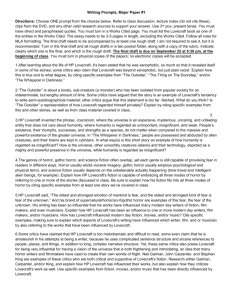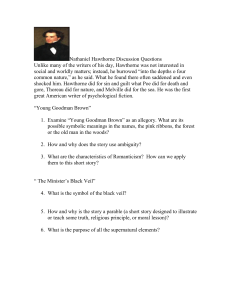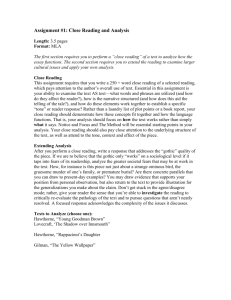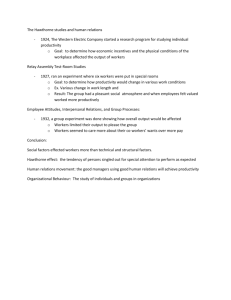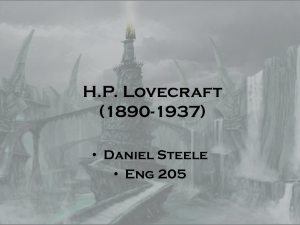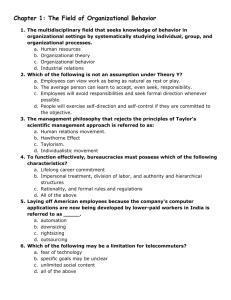Hawthorne & Lovecraft: Isolation & Terror in New England Settings
advertisement
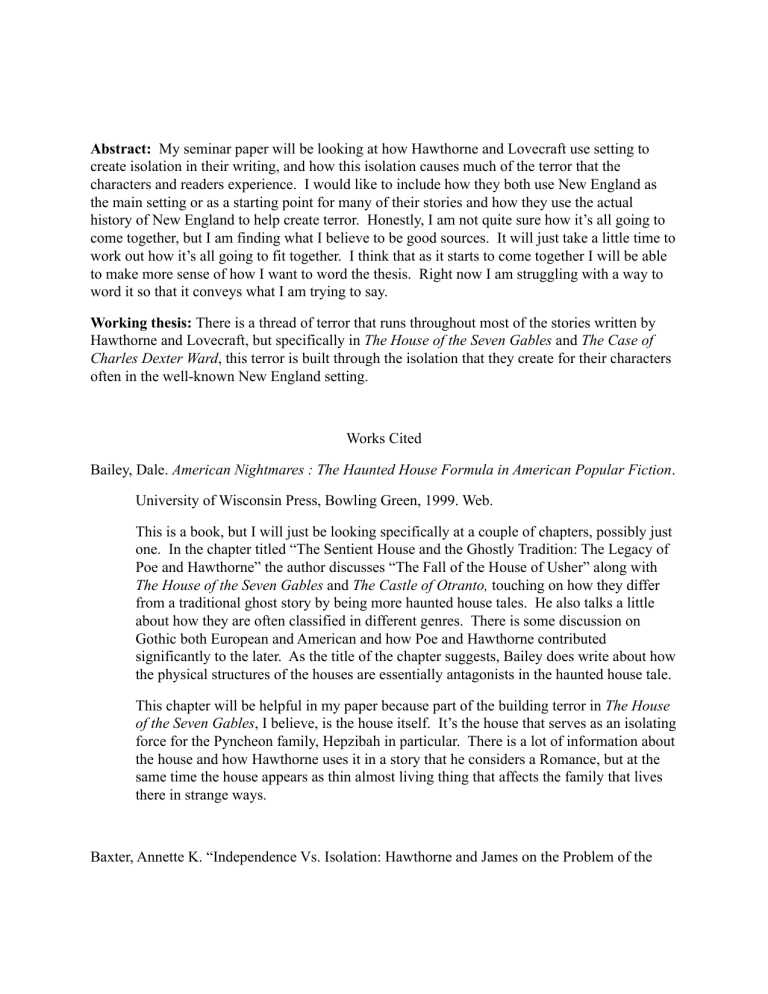
Abstract: My seminar paper will be looking at how Hawthorne and Lovecraft use setting to create isolation in their writing, and how this isolation causes much of the terror that the characters and readers experience. I would like to include how they both use New England as the main setting or as a starting point for many of their stories and how they use the actual history of New England to help create terror. Honestly, I am not quite sure how it’s all going to come together, but I am finding what I believe to be good sources. It will just take a little time to work out how it’s all going to fit together. I think that as it starts to come together I will be able to make more sense of how I want to word the thesis. Right now I am struggling with a way to word it so that it conveys what I am trying to say. Working thesis: There is a thread of terror that runs throughout most of the stories written by Hawthorne and Lovecraft, but specifically in The House of the Seven Gables and The Case of Charles Dexter Ward, this terror is built through the isolation that they create for their characters often in the well-known New England setting. Works Cited Bailey, Dale. American Nightmares : The Haunted House Formula in American Popular Fiction. University of Wisconsin Press, Bowling Green, 1999. Web. This is a book, but I will just be looking specifically at a couple of chapters, possibly just one. In the chapter titled “The Sentient House and the Ghostly Tradition: The Legacy of Poe and Hawthorne” the author discusses “The Fall of the House of Usher” along with The House of the Seven Gables and The Castle of Otranto, touching on how they differ from a traditional ghost story by being more haunted house tales. He also talks a little about how they are often classified in different genres. There is some discussion on Gothic both European and American and how Poe and Hawthorne contributed significantly to the later. As the title of the chapter suggests, Bailey does write about how the physical structures of the houses are essentially antagonists in the haunted house tale. This chapter will be helpful in my paper because part of the building terror in The House of the Seven Gables, I believe, is the house itself. It’s the house that serves as an isolating force for the Pyncheon family, Hepzibah in particular. There is a lot of information about the house and how Hawthorne uses it in a story that he considers a Romance, but at the same time the house appears as thin almost living thing that affects the family that lives there in strange ways. Baxter, Annette K. “Independence Vs. Isolation: Hawthorne and James on the Problem of the Artist.” Nineteenth-Century Fiction, vol. 10, no. 3, 1955, pp. 225-231. In this article, Baxter talks mostly about how Hawthorne and James treat the Artist in their different stories. She goes into the specifics of a handful of stories by the two writers where the main character is an artist and how he can be threatened by isolation. She does say that this “sin of isolation” isn’t only found in artists but that’s her specific focus. Basically the paper states that isolation may be important for the artist’s work, but it’s also very important for the artist to retain his humanity during this isolation. This is an interesting view on how artists need some degree of isolation because of how it fuels their creativity. It’s definitely something that could help inform my paper, because it’s focused on isolation in a way that is different from how I have been looking at it thus far. I have been viewing isolation as something that the character chooses or is imposed on them, not as something that is necessary for that character to grow creatively. Dziemianowicz, Stefan. “Outsiders and Aliens: The Uses of Isolation in Lovecraft's Fiction.” An Epicure in the Terrible: A Centennial Anthology of Essays in Honor of H. P. Lovecraft. Edited by David E. Schultz, and S. T. Joshi. Literature Resource Center; Gale. Web. In this source, the author talks about how Lovecraft uses isolation in various stories. It’s actually quite a long article and pretty detailed covering a lot of Lovecraft’s work. He specifically states that Lovecraft are nearly always placed so that they have to face their horror alone, which leaves them with no other person to corroborate their story. This is a horror in itself. The author also does point out that Lovecraft, unlike Poe, doesn’t feel the need to make them mad in order to isolate them. Toward the end he talks more about how Lovecraft’s writing mirrored the stages of his life and how he recycled themes from early fiction, but he was always a pioneer in his writing. There is a lot of information in this article that would be fodder for this paper. If nothing else, it points out just how much Lovecraft uses isolation in his work. That alone makes it applicable for my topic. It will be good starting point for really digging deeper into the stories presented to find out just what Lovecraft was doing when he isolated particular characters in these stories. Evans, Timothy H. “A Last Defense Against the Dark: Folklore, Horror, and the Uses of Tradition in the Works of H. P. Lovecraft.” Journal of Folklore Research, vol. 42, 2005, pp. 99+. General OneFile; Gale. Web. This article by Evans is about Lovecraft, his history and how he was motivated by his fear of the loss of culture. This fear is what led to his racism and motivated much of his writing. Evans also talks about how Lovecraft’s writing is also influenced by his travel and how he uses folklore to evoke horror. There is a whole section of the article on architecture and how Lovecraft’s interest wasn’t historical, but aesthetic. He liked floor plans and window and door placement and details of structures. This is a lengthy article that talks more about his history, miscegenation and how his feelings about this come through in specific stories. Evans talks about many different stories in this article and how Lovecraft uses folklore and tradition in them. I think there is a lot from this article that I will be able to use in my paper. I am not necessarily focusing on the use of tradition and folklore, but I am focusing on setting and Evans does talk about the New England setting and some of the traditions that Lovecraft draws on from that area. I will also be able to look more closely at what he has to say about the stories that I will be focusing on. Hawthorne, Nathaniel, and James McIntosh. Nathaniel Hawthorne's Tales. Norton, New York [u.a.], 2013. This book is a compilation of Hawthorne’s stories, essays, and criticism written about Hawthorne and those stories. It covers a little of Hawthorne’s personal history and numerous letters he wrote through the years. I will mostly be using this as a source for background on Hawthorne that I may pull from the preface and one piece of criticism written by Jorge Louis Borges titled “Nathaniel Hawthorne.” I will also be using it as a source for the short story “Young Goodman Brown” when I address it in the paper. Hones, Sheila. “Literary Geography and the Short Story: Setting and Narrative Style.” Cultural Geographies, vol. 17, no. 4, 2010, pp. 473-485. Materials Science & Engineering Collection. Web. This article focuses mostly on setting for short stories in general. She talks a little about thematic settings and does reference an article that was written about Lovecraft and his settings. She goes on a bit about how Lovecraft uses setting as often fantastical places that leave his readers uncertain as to where they will go. She writes some about narrative style and description in short stories as well. Then she goes on to do a close read of a story that’s not relevant to my paper. I am not sure that I will end up using this source, but I am going to use the source that she references in the article. If I do use this one it will be more for the general information that she gives about setting and narration. Hurley, Paul J. “Young Goodman Brown's “Heart of Darkness.” American Literature, vol. 37, no. 4, 1966, pp. 410-419. JSTOR. Web. In this source Hurley is looking specifically at “Young Goodman Brown” and what exactly his experience in the forest that night was. Was it real or a nightmare? He contends that Brown is indeed evil and that his experience is a result of that evil. He also believes that Hawthorne makes clear that Brown’s purpose on that night was an evil one. That the wife’s name is Faith is Hawthorne’s way of showing that Brown has turned from his religious faith to the evil that he is seeking on this night. Hurley argues that the Devil was in the forest that night with Goodman Brown and that he surrenders to evil. Since I am want to look at this story more closely, this is a good one to show how Goodman Brown goes into the isolation of the forest that night. There is a very horrific aspect in looking at this the way that Hurley does in this essay. He is saying that Brown isn’t led to his doom by some unknown force, but that he went willingly because he was evil in his heart, and I think that this will be interesting to dive deeper into. Janicker, Rebecca. “New England Narratives: Space and Place in the Fiction of H. P. Lovecraft.” Extrapolation, vol. 48, no. 1, 2007, pp. 56. In this article, Janicker talks specifically about how Lovecraft can be viewed as a regionalist writer. She is looking at a couple stories in particular and how he takes an actual town and uses the local color to lend an authenticity to them. She is looking at “The Colour Out of Space” and “The Shadow Over Innsmouth” specifically. She talks about how the environment can create a landscape of horror and how Lovecraft does this in these stories. There is a section on American Gothic literary style and what features it has and where they come from. She goes into some detail about how Lovecraft sets many of his tales in New England because it’s his home and how he uses this authentic place to create realms of horror. She argues that his regionalised horror fiction conveys how he fears his own homeland. There is a lot of information in this article that will be helpful for my paper. I think the idea that Lovecraft uses a known and real setting for some of his horrific stories makes them seem more real and grounded even when they are really too fantastical to be real. I also like that she speculates that his fear of his home is reflected in his horror set here. Kneale, James. “From Beyond: H. P. Lovecraft and the Place of Horror.” Cultural Geographies, vol. 13, no. 1, 2006, pp. 106-126. Engineering Database. Web. This paper by Kneale deals with how Lovecraft uses geographies beyond representation to create horror. This doesn’t always mean a setting in space, but often a place that is recognizable, but used in a way that is beyond the reader’s recognition. He looks at Lovecraft specifically because, as he explains it, Lovecraft’s work consistently discusses “the beyond” in way that are interesting to geographers and his imagination of these places and beings is more strange than other horror conventions. Kneale also thinks that Lovecraft’s personal history encourages “a particular reading of his work” that he wishes not to replace. He talks about all of these things more in depth while referencing particular stories. I think that this will be a really helpful paper to use as a source for my own paper. It’s look at the beyond that Lovecraft uses is particularly interesting because of the way that he approaches it and ties it into horror. He does talk about space some, but he grounds it in New England at the same time, which is what will be the most helpful for my paper. Lovecraft, H. P., and Darrell Schweitzer. Supernatural Horror in Literature & Other Literary Essays. Wildside Press, 2008. This is an essay written by Lovecraft where he basically details what supernatural horror is in literature. He talks about the plot lines of numerous stories that fit into this category and how they fit. He does detail the work of specific authors, periods, and places as well. He sort of gives his opinion of these stories and whether he believes them to create the horror they claim by being classified the way they are. There is a chapter where he discusses Hawthorne and Weird fiction in America that I may use in my paper. I think that using Lovecraft’s opinion on Hawthorne in a paper that tries to create a connection between them could be a good thing. I will only use it if I can tie it in to what I am trying to show, but I think it will work. Milder, Robert. “Hawthorne and the Problem of New England.” American Literary History, vol. 21, no. 3, 2009, pp. 464-491. JSTOR. Web. This paper starts with the author stating that Hawthorne is essentially not a writer who can be removed from his birthplace and “authorial home”. He centers all of his work around four major setting of his own habitation. He was haunted by Salem’s history and presumably his ancestor’s part in it and that’s why it’s a focus of much of his work. Milder speaks about how Hawthorne uses The House of the Seven Gables as work of self-therapy. He does talk about how other stories fit into the setting and why that’s important and how Hawthorne is looking at the history of the Puritans as well as other influences in New England during the time his stories take place. I will be looking at the New England setting and how Hawthorne uses the history of Salem and Puritan history to build horror/terror in “Young Goodman Brown”. I will also look at the section on The House of the Seven Gables more in depth as I talk about that in my paper. Simmons, D. New Critical Essays on H.P. Lovecraft. Palgrave, DE, 2013. This is a book of essays collected by the editor David Simmons. For the purpose of this, I am focusing on just the introduction chapter written by Simmons, “H.P. Lovecraft: The Outsider No More?”. He talks a bit about how Lovecraft’s story “The Outsider” is often considered autobiographical. Simmons goes into some detail about how Lovecraft withdraws from society and is himself an outsider of sorts. He goes on to talk about how this could have bearing on some of his work. The bulk of the rest of the chapter introduces each of the chapters and authors included in the book and how the range of topics adds to the diversity of commentary on Lovecraft’s work. I am not sure how much of this I would use for my paper, but I do think his observations about Lovecraft’s own isolation could be helpful in some way. It could be a way to start thinking about how Lovecraft uses isolation in his work and what importance his own history plays in that.
